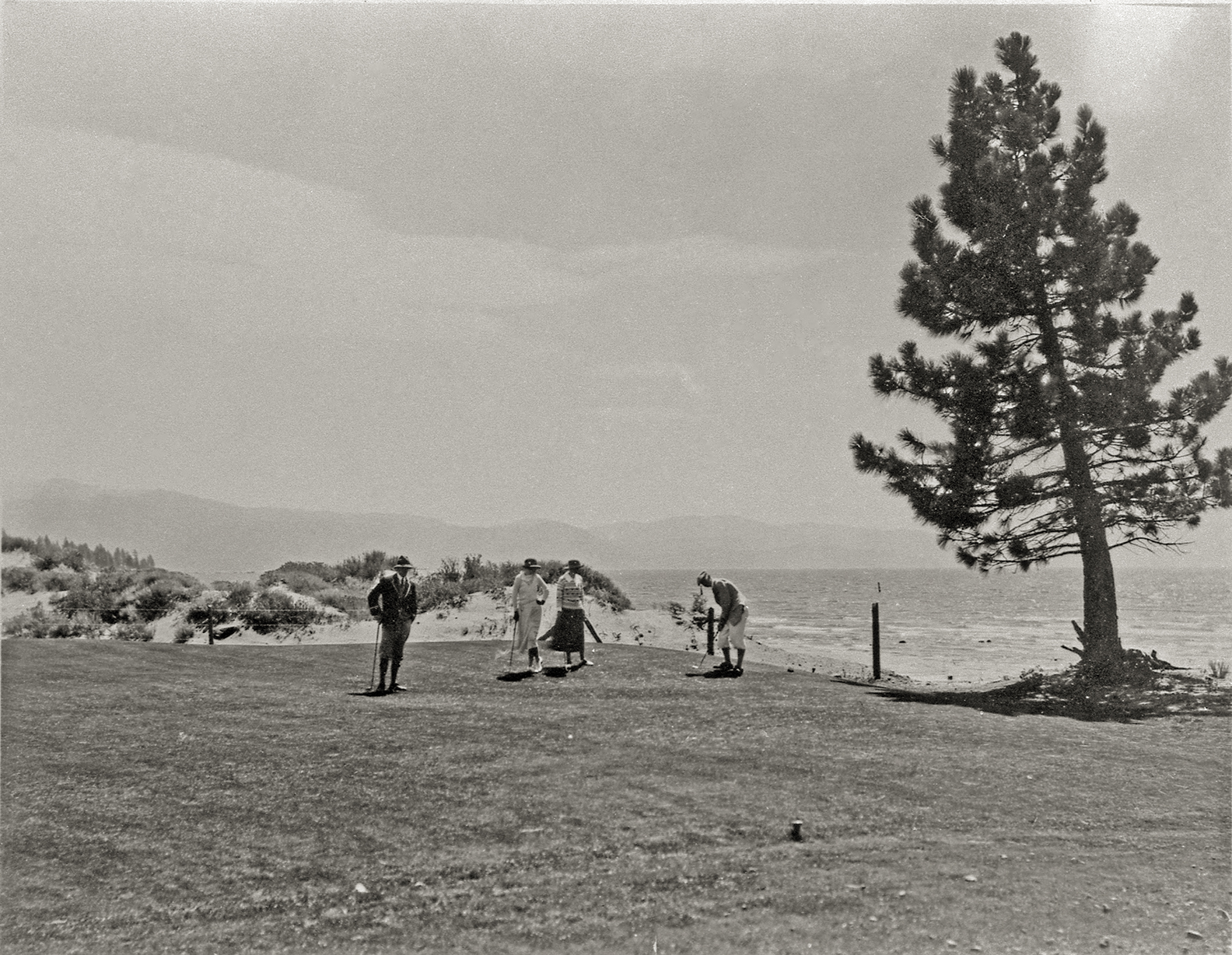
25 Jun The Links of Tahoe Lore
Mirroring national trends, the history of golf at Lake Tahoe can be traced to a series of popularity booms in the industry
There is an old joke that encapsulates the deep but torturous love affair people have with the game of golf. It begins with a woman dying after a golf ball strikes the back of her head on the first hole.
“Her husband was so distraught, he played only the front nine,” goes the punchline.
It’s a beguiling thing that something so frustrating—Mark Twain called the game “a good walk spoiled”—can elicit such passionate devotion.
The game is modeled on an ancient Roman contest called paganica, where contestants wielded bent sticks to strike a stuffed leather ball. But the modern iteration sprang up in Scotland in the fifteenth century.
The main reason historians are certain of this timeline is that James II, King of Scotland, signed a law in 1457 banning golf because men were obsessively practicing the sport instead of archery, which was necessary for the national defense.
The sport was unstoppable, though, taking hold as a national pastime in Great Britain in the 1700s and picking up in popularity in the United States in the twentieth century.
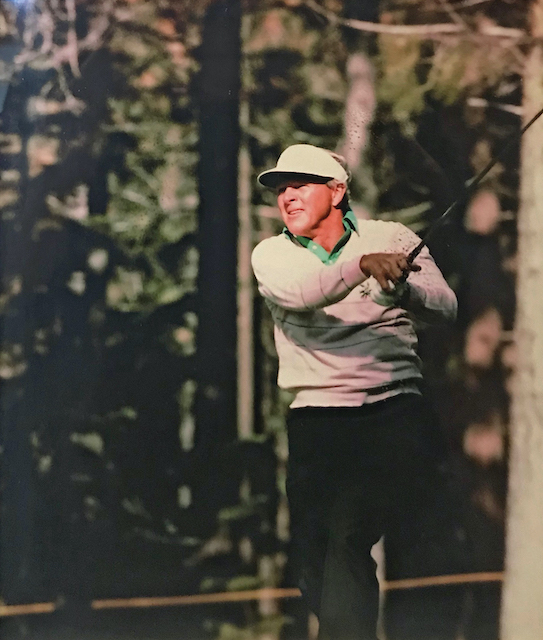
Arnold Palmer at Edgewood Tahoe during the 1985 U.S. Senior Open, photo courtesy Edgewood Tahoe
Golf at Tahoe
The sport took off at Lake Tahoe at relatively the same time as the rest of the country, with the first course opening for business in 1918, only two years after the Professional Golfers’ Association of America was formed and only a generation removed from John C. Fremont becoming the first man of European descent to espy North America’s largest alpine lake, in 1844.
On the other hand, golf’s advent in the 1920s at Lake Tahoe tracks well with the overall development of the region, which morphed from a timber hotbed providing wood for mines in Nevada and California in the late 1800s to becoming a playground for the affluent by the Roaring Twenties.
Golf has always been, and to some degree still is, associated with the wealthy, so the fact that golf courses cropped up around the time the gentry of San Francisco identified Tahoe as an ideal place to recreate is no coincidence.
But the sport’s evolution is more broadly mirrored in the microcosm of Lake Tahoe. Just as Arnold Palmer, a working-class kid from a steel mill town in western Pennsylvania, started racking up championships in the 1950s, Tahoe expanded its offerings to accommodate the spike in interest.
And then again in the 2000s, after Tiger Woods brought golf to an entire generation of young people, an even further expansion of course offerings came on the market.
Now, in 2020, Lake Tahoe offers one of the most complete and varied golfing experiences anywhere in the world.
Whether it’s putting on the same greens as Frank Sinatra and Bing Crosby, teeing off on a dogleg par 5 designed by Jack Nicklaus, or chipping up to the finishing green framed by a background of the lake’s sparkling blue surface, Tahoe has something for everybody.
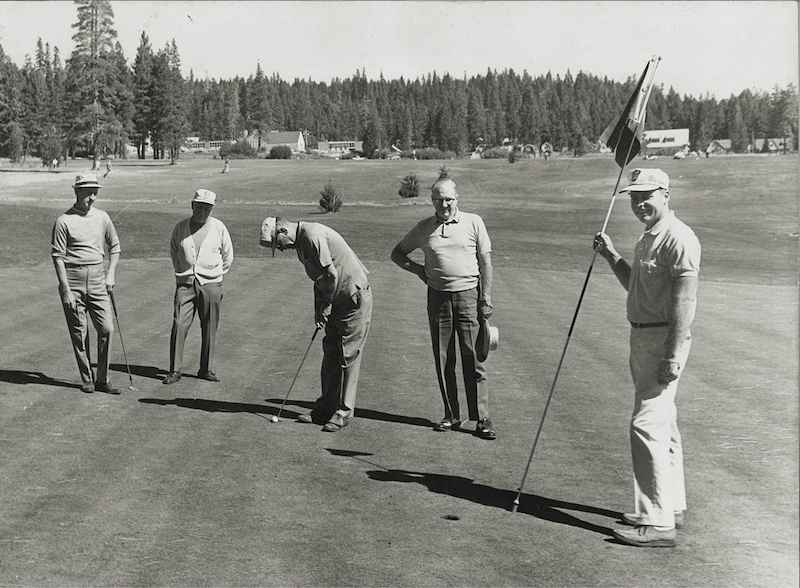
The Tahoe City Golf Course has a long, illustrious history, opening in 1918 as the Tahoe Tavern Links, photo courtesy Tahoe City Public Utility District
The Advent
The Tahoe City Golf Course, then known as the Tahoe Tavern Links, opened for business in 1918. It was designed by the famed golf course architect and women’s rights pioneer Isabella May Dunn-Webb Hupfel, better known by her nickname, “Queenie.”
Dunn-Webb was born in Southampton, England, in 1880 at a time when women were not expected to partake in the golfing pastime.

The Tahoe City Golf Course was designed by famous golf course architect and women’s rights pioneer Isabella May Dunn-Webb Hupfel, who was better known as “Queenie,” photo courtesy Tahoe City Public Utility District
However, Dunn-Webb was the daughter of Thomas Gourlay, the famed “Keeper of the Green” for the Royal Blackheath golf club in London. While women did not commonly play golf, Dunn-Webb’s mother occasionally gave golf lessons and was reputed to be an effective aid to the ailing games of various duffers.
Dunn-Webb moved to the United States after a couple of failed marriages and immediately followed in her mother’s footsteps as a golf professional who gave incisive lessons to golfers in and around New York.
In 1916, Dunn-Webb headed west, landing in Reno, where she saw an opportunity due to the lack of existing golf courses. Soon enough, she enlisted the enthusiasm of male golfers in Northern Nevada and founded the Reno Golf Club in 1917, with nine holes, a clubhouse and a five-room cottage.
The move caught the notice of Charles Bliss, the wealthy owner of the Tahoe Tavern in Tahoe City. In 1918, Bliss hired Dunn-Webb to build him a golf course as an amenity to his resort tucked on the northwest shore of Lake Tahoe.
Queenie took the train up to Tahoe City and, before 1918 had elapsed, she had built Bliss a six-hole golf course called the Tahoe Tavern Links. Dunn-Webb added three more holes in 1921 and served as the course manager and golf pro until marrying another wealthy capitalist and moving back to New York.
When Dunn-Webb was managing the course, the greens were comprised of sand, as was common at the time. It wasn’t until 1931 that the course introduced irrigation and grass.
The Tahoe City Golf Course changed hands a few times in the twentieth century, with Carl Bechdolt Jr. and wife Elsie buying the course in 1948. The Bechdolt family held the course for decades before it sold it to a consortium of public entities, including Placer County and the Tahoe City Public Utility District.
The links in Tahoe City have played host to no shortage of golf-playing celebrities through the years, including Bob Hope, Frank Sinatra, Dean Martin and Sammy Davis Jr.
Today the course is considered a solid and affordable municipal course widely accessible to anyone who wants to play.

Bob Hope and Bing Crosby were among the many celebrities who played at Old Brockway Golf Course, photo courtesy Old Brockway
Old Brockway
The little nine-hole course in Kings Beach has an illustrious history that matches that of any course in the country, let alone Lake Tahoe.
Brockway was originally constructed in the 1920s and opened to the public in 1924 as an amenity to the Old Brockway Springs Resort.
It was commissioned by Harry Comstock, owner of the resort, and built by Scottish architect John Duncan Dunn.
“He was one of the four horsemen of golf architects at the turn of the century,” says Lane Lewis, owner and proprietor of Old Brockway Golf Course.
“Harry Comstock met Dunn down in Pasadena, where Comstock also operated the Vista del Arroyo Hotel,” says Lane. “Dunn had just been hired by the Wrigleys from Chicago to build a course on Catalina Island.”
Comstock offered Dunn the opportunity to build a course in Tahoe after he finished that one. Dunn was no slouch, as he also designed Shinnecock Hills in New York, one of the world’s great golf courses and host to a U.S. Open as recently as 2018.
Brockway has some of the same elements as all Dunn-designed courses—tight fairways and turtleback greens that reward precision play and adroit shots with the irons. It also has something that Shinnecock doesn’t—a finish that features Lake Tahoe glimmering in the background.
But what truly makes the venerable Old Brockway so legendary is the history of the diverse and famed personalities who graced its greens.
“Bing Crosby was entertaining at the Cal-Neva in 1934 and 1935, and he would invite his friends up to Tahoe to play golf,” Lewis says. “They would play here every afternoon and then entertain at the Cal-Neva.”
Bing Crosby put on a little tournament during his summer sojourns at Tahoe that featured a clambake and a modest purse for the winner. The tournament soon became so popular they had to move it to the famed Pebble Beach, just south of Monterey, which morphed into the AT&T Open—a pro-am on the PGA Tour.
But it wasn’t just Crosby.
Sinatra and his Rat Pack buddies, Sammy Davis Jr. and Dean Martin, played there often during the 1950s while they were ensconced at the Cal-Neva. Joseph Kennedy, the father of President John F. Kennedy, used to ply the woods in the fairways of Old Brockway, and President Dwight Eisenhower once played the course too.
“It’s the most illustrious course in Lake Tahoe,” Lews says.
Glenbrook
Lake Tahoe boasts another slender nine-hole course that plays along its shores and has had no shortage of famed personalities bid for par since it opened in 1926.
The community of Glenbrook, tucked into the southeast corner of Tahoe, began as an elaborate timber holding providing wood to the silver mines flourishing in Virginia City, starting in the 1860s.
At one point, the Carson and Tahoe Lumber and Fluming Company held approximately 50,000 acres of timberland in the Lake Tahoe Basin and the east slope of the Sierra Nevada. As activity in the mines dwindled at the advent of the twentieth century, high-end tourism filled the void as the Glenbrook Inn opened its doors in 1907. Mark Twain, Rita Hayworth, Ulysses S. Grant and Clark Gable all signed the guestbook, according to the Glenbrook Club.
But it was the visit of a famous golfer that marks the most famous moment in Glenbrook’s history.
Ben Hogan, widely considered to be the most influential golfer in the sport’s history, paid a visit to the course in 1948. Hogan had just played a tournament in Reno and was on his way home to Texas when he was convinced to play an 18-hole exhibition at the course. The public flocked to Glenbrook and paid $1.50 just for the right to watch him play. He scored a 5 under par.
“I heard it was Ben Hogan’s favorite nine-hole course in the country,” says Phil Weidinger, a longtime Tahoe PR professional and avid golfer.
Local historian Mark McLaughlin recounts a Hollywood story involving Glenbrook. Robert Wagner, the famed actor, was caddying for Clark Gable, who introduced him to a major Hollywood mogul, thereby launching Wagner’s storied career.
Today Glenbrook is a private course that enjoys a sterling reputation for those fortunate enough to play it.
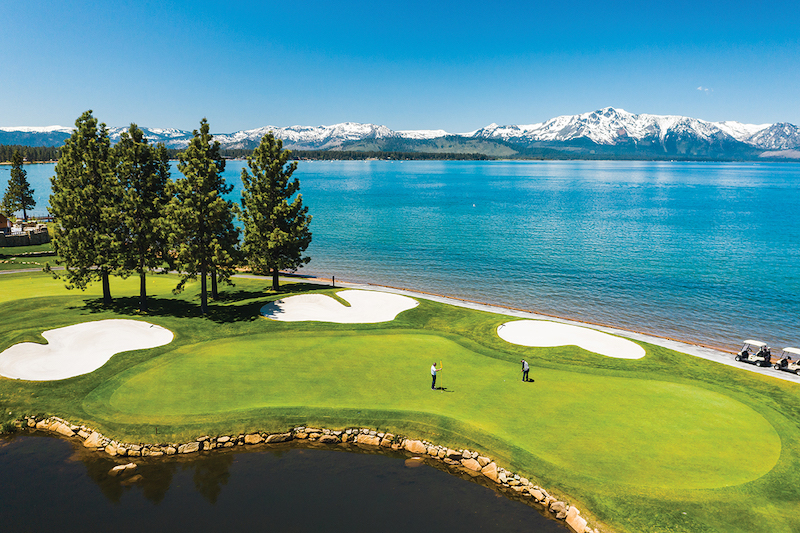
Edgewood Tahoe Golf Course, photo courtesy Edgewood Tahoe
The Second Boom
While most golf historians focus on the fabled era of the 1920s at Lake Tahoe, the 1960s brought a new explosion of golf courses.
“In the 1960s most of the courses that were built were real estate driven,” Lewis says. “For instance, the Northstar course was built in 1968 as an amenity to the real estate development and the ski resort.”
Designed by the famed golf architect Robert Muir Graves, the Northstar Golf Course is renowned for its links-style experience through the Martis Valley that evolves into a more traditional mountain golf course on the back nine.
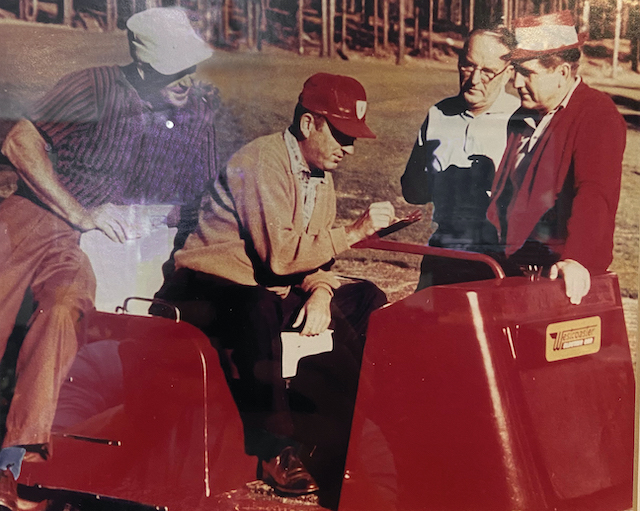
From left, Bill Montgomery, Harold Tiller, Art Wood and Ray Plunkett at the Incline Village Championship Golf Course, which opened in 1964, photo courtesy IVGID
Around the same time, Boise Cascade was developing Incline Village with a unique single plan for the 9,000-acre luxury community on the Nevada side of Tahoe’s North Shore. Along with the construction of Diamond Peak Ski Resort, the executives at Boise Cascade knew their residents would expect to have golf as an amenity, so they turned to the famed golf course builder Robert Trent Jones.
British-born, Jones was one of the most prolific golf course designers of his era, building more than 500 courses throughout 35 countries and 45 U.S. states.
“The sun never sets on a Robert Trent Jones golf course,” he used to say.
Hired by Boise Cascade in 1964, he built the Championship Course to accentuate the natural scenery of that part of the Basin and facilitate a challenging but accessible style of play. Four years later Jones built the Mountain Course in Incline Village, which makes ample use of the Sierra scenery to forge a picturesque executive course popular with residents and visitors.
The decade also saw the construction of the Lake Tahoe Golf Course, fashioned in 1962 by designer William Bell in part of the Upper Truckee River meadow. The river winds through the course that affords blown-open views of Mount Tallac, Twin Peaks and Heavenly and is the only Certified Audubon Cooperative Sanctuary located in South Lake Tahoe.
While all of these courses have made their mark, the crown jewel of the 1960s courses is undeniably the Edgewood Tahoe Golf Course.
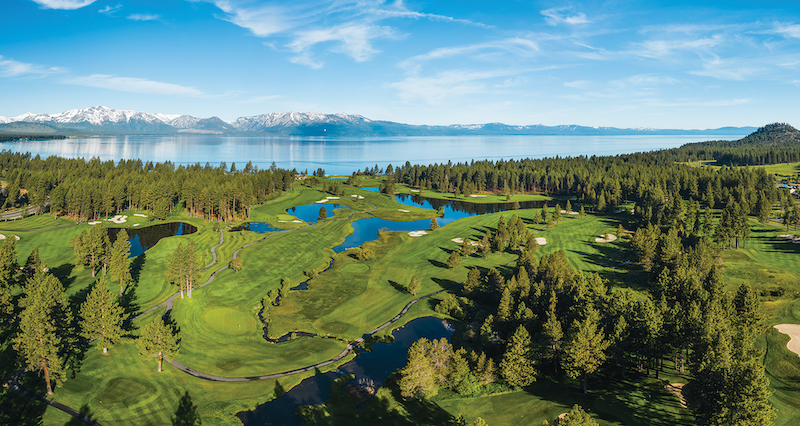
Edgewood Tahoe Golf Course pictured from above, photo courtesy Edgewood Tahoe
Edgewood Tahoe
“There is no other place like it in the world,” Weidinger says of Edgewood Tahoe. “You’re right on the lake.”
Edgewood is the gold standard for scenic 18-hole golf courses at Lake Tahoe. It hosts the annual American Century Championship, a celebrity golf tournament that is as famous for Charles Barkley’s hideous golf swing as it is for the quality of play.
But the course is more than just home for the high-profile tournament, as its challenging yet fair design beguiles scores of golfers every year and consistently ranks among Golf Digest’s “America’s Top Golf Courses.”
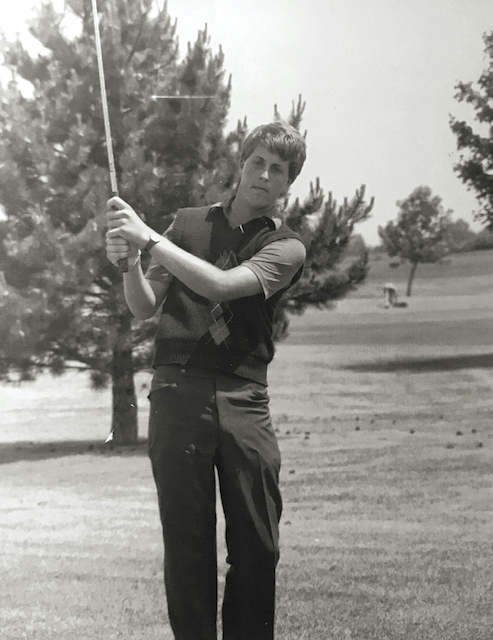
Phil Michelson at Edgewood Tahoe Golf Course during the 1987 Lake Tahoe Classic, photo courtesy Edgewood Tahoe
Opening in 1968, the course was designed by George Fazio, who is still heralded for his visionary work. Hole 16 runs right into the lake, while 17 runs right along the shore of Lake Tahoe. During the American Century Championship, recreational boaters line up to see the celebrities hit their tee shots on the scenic Par 3.
Before it became a golf course it belonged to the Park family, some of the original homesteaders in the area who ran cattle down in the Carson Valley beginning in the 1860s.
They bought the property on which Edgewood now sits as a summer pasture for their livestock, running their herd up Kingsbury Grade on a five-day trip from the Topaz Lake area.
The area also functioned as a stop on the short-lived but famed Pony Express, the mail service that used a relay system of riders to carry messages across the country.
But by the 1960s, the Park family didn’t need the land anymore and modern transportation made a cattle drive up Kingsbury Grade a thing of the past, so they began to look at potential uses for the property.
“It was a family decision to build Edgewood Tahoe and to beautify the area,” Brooks Park told James McKinney in 1985 for an article the U.S. Senior Open program. Brooks Park co-owned and co-operated the golf course with his sister Margaret Park Pruett, who took the majority of responsibility for the day-to-day operations.
After hosting the U.S. Senior Open in 1985, executive producers at NBC took notice of the peerless scenic settings at the course. When the network lost the rights to Major League Baseball in 1990, it was looking for a way to fill the dead air.
The network landed upon the American Century Championship. Initially, the tournament struggled to find a sponsor, but then Michael Jordan, John Elway and Mario Lemieux, all of whom also played in the tournament, agreed to sponsor it. The event has been a summer staple at Lake Tahoe ever since.
The Tiger Boom
“The Baby Boomers always loved to play golf, but the game started to decline a little bit until Tiger Woods,” Lewis says.
When Woods sunk a putt on the 18th green at Augusta National in April 1997 to win the Masters Tournament by a record 12 strokes, the moment not only reverberated through professional golf, it changed the face of the recreational sport throughout the country.
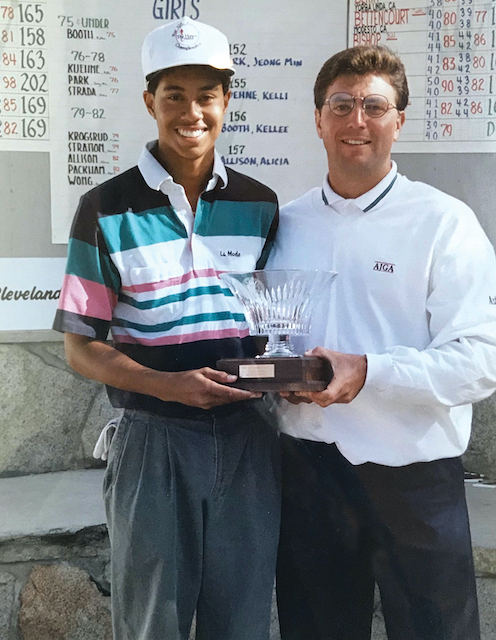
Tiger Woods at Edgewood Tahoe Golf Course after winning the 1992 Lake Tahoe Classic, photo courtesy Edgewood Tahoe
“There is no question Tiger accelerated golf participation by taking it out of the country club and into the broader public,” Lewis says.
He witnessed the boom firsthand at Brockway, where demand for tee times jumped in the late 1990s and the early 2000s. But the boom was also reflected more broadly throughout Lake Tahoe and, particularly, in Truckee, where Lahontan Golf Club debuted its private Tom Weiskopf-designed, 18-hole championship course in 1998.
In 2000, Brad Bell, a former PGA golf pro, designed Coyote Moon, an 18-hole golf course in Truckee that qualifies as one of the most challenging and beautiful public 18-hole courses in the area.
Next, Old Greenwood came online in 2004. Designed by legendary golfer Jack Nicklaus, Old Greenwood is a quintessential mountain course.
“Some say it’s an unusually friendly version of a Nicklaus Signature design,” Matt Ginella wrote in Golf Digest. “That might be, but only if you can avoid the especially deep bunkers.”
Then in 2007, the Golf Club at Gray’s Crossing opened. Right next door to Old Greenwood, Gray’s Crossing was designed by golfer and outsize personality Peter Jacobsen, along with Jim Hardy. The course makes use of towering Jeffrey pines and natural wetlands to provide a challenging round for any level of golfer.
Down the road, Schaffer’s Mill opened in 2008, just as the Great Recession set in. Regardless, the course designed by Johnny Miller and the late John Harbottle is no worse for the wear, with one of the more varied landscapes of any course in the area. It uses meadows, forests, lakes, streams and rock outcroppings to great effect.
“The bright-white sand bunkers and the lush, tree-lined fairways can give a golfer with blurry vision the impression he’s playing Augusta National,” Ginella wrote.
Also opening in 2008, neighboring Martis Camp Golf Club was designed by Tom Fazio, who called the rolling, forested property at the base of Northstar one of the finest properties on which he’s ever designed a course. The 18th hole is particularly dramatic, with stellar views of the Carson Range and a world-class clubhouse perched atop a 70-foot-high rock outcropping.
The following year, in 2009, Ben Crenshaw, who won the Masters twice and went by the moniker “Gentle Ben” during his playing days, put the finishing touches on the course at Clear Creek Tahoe along with co-designer Bill Coore.
Clear Creek is situated in the southeast portion of the Basin on a saddle that affords views of the Carson Valley, without losing its inimitable mountain setting. A private course, it nevertheless consistently draws praise from those with the good fortune to play it.
“The layout surges and spills naturally along the lilting slopes, without ever once feeling forced or goofy,” Josh Sens told Golf Magazine. “It’s golf architecture as artistry—an elevated course in rarefied air.”
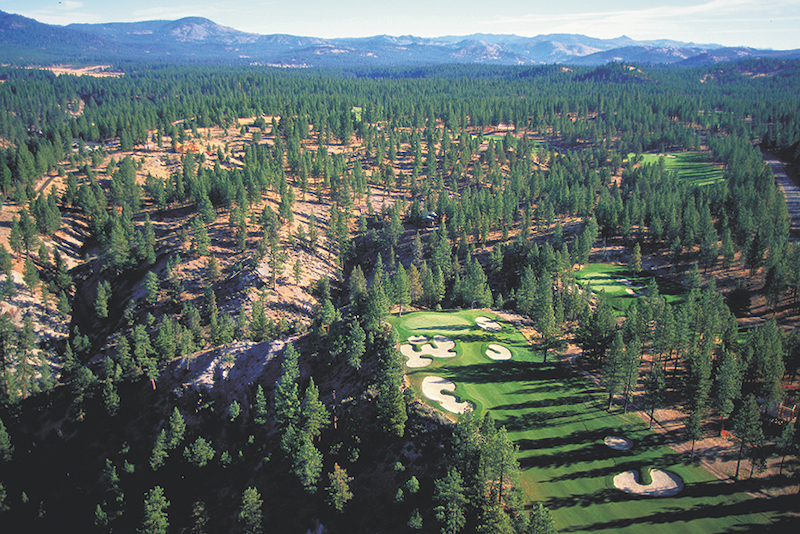
The Dragon Course at Nakoma Resort, which opened in 1998, is one of several quality courses in the Lost Sierra region north of Truckee, photo courtesy Nakoma Resort
Graeagle
The third explosion of golf course construction wasn’t just restricted to Truckee and the South Shore. North of Truckee, as the mountain scenery opens up toward Graeagle, a wealth of courses that opened up in the last 20 years or so also provide tracks for all levels of golfers.
In the late 1990s, the Whitehawk Ranch Golf Club opened in scenic Mohawk Valley. Once named as one of the top 20 golf courses in the United States, Whitehawk is worth the hour-long drive from Truckee for avid duffers.
The Dragon at Nakoma, which opened in 1998, features steep slopes, tricky hazard placement and secluded forests befitting the region’s “Lost Sierra” moniker. Grizzly Ranch, built in 2005, is surrounded by more than a million acres of national and state forest, offering a unique golf experience full of tranquility and solitude.
Graeagle Meadows, which dates back to 1969, and Plumas Pines, opened in 1980, are also courses that earn rave reviews from the slicers who make the trip.
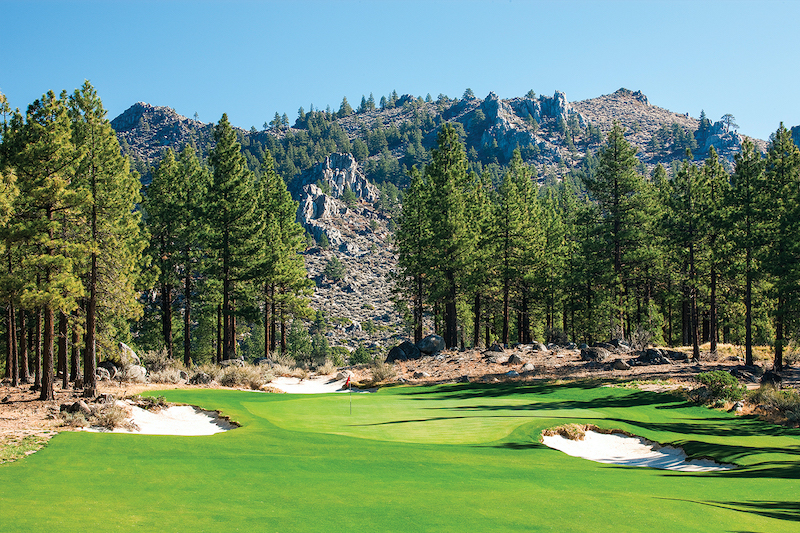
The Clear Creek Tahoe course designed by Ben Crenshaw and Bill Coore, photo courtesy Clear Creek Tahoe
Mountain Golf
Arguably more than any other mountain location, the Lake Tahoe region features a wide range of golf courses in terms of cost, accessibility, difficulty and length.
“It’s one of the best golf destinations anywhere,” Weidinger says. “There are 44 courses all within an hour of each other and I love mountain golf, with the scenery, streams, mountain ridges and all that. Plus, the ball travels farther in the thin air.”
But the plethora of golfing options at Tahoe materialized in an incremental fashion, starting with the sport’s first explosion in popularity at the beginning of the twentieth century, followed by the expansion of golf into the blue-collar segment of society in the 1950s and 1960s, and the revolution and engagement with younger clientele in the late 1990s and early 2000s largely attributable to Tiger Woods.
The evolution of golf at Tahoe mirrors the evolution of the pastime throughout the country, with the only difference being the region’s unparalleled scenery creating the ideal background for another round.
Matthew Renda is a Santa Cruz-based writer and former Tahoe resident.




John Delbert Rey
Posted at 15:07h, 19 FebruaryYou forgot Tahoe Paradise Golf Course in Meyers. I am 73 with hdcp 13. This is the hardest shortest course you’ll ever play. Built on the side of a mountain, short putts can a huge amount of break. Really fun course. Low key, un-asuming.
Marty Mattson
Posted at 11:43h, 15 JuneMissed one of the best Tahoe Donner! Just renovated 2020 it’s great.
AGP
Posted at 13:34h, 11 AprilWhile Robert Trent Jones Sr did design the Incline Village Championship Course, he did not also design the Mountain Course, as your story asserts. His son did.